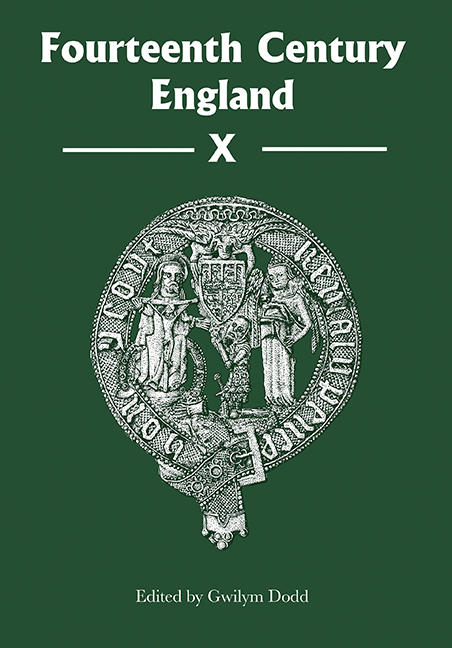Book contents
- Frontmatter
- Contents
- List of Illustrations
- Contributors
- Preface
- Abbreviations
- ‘Bought by the King Himself’: Edward II, His Chamber, His Family and His Interests in 1325–26
- Parliament in the Reign of Edward II
- The Representation of the Clergy in Parliament
- Feeding Mars: Military Purveyance in the Long Fourteenth Century
- ‘Unnatural in Body and a Villain in Soul’: Rape and Sexual Violence towards Girls under the Age of Canonical Consent in Late Medieval England
- Marriage and Inheritance: The Element of Chance in the Development of Lay Estates in the Fourteenth Century
- Mary Percy and John de Southeray: Wardship, Marriage and Divorce in Fourteenth-Century England
- Richard II's Kingship at St Stephen's Chapel, Westminster, 1377–99
- Bodies in Constant Motion: The Burials and Reburials of the Plantagenet Dynasty, c. 1272–1399
- Fourteenth Century England Issn 1471–3020
Bodies in Constant Motion: The Burials and Reburials of the Plantagenet Dynasty, c. 1272–1399
Published online by Cambridge University Press: 03 July 2019
- Frontmatter
- Contents
- List of Illustrations
- Contributors
- Preface
- Abbreviations
- ‘Bought by the King Himself’: Edward II, His Chamber, His Family and His Interests in 1325–26
- Parliament in the Reign of Edward II
- The Representation of the Clergy in Parliament
- Feeding Mars: Military Purveyance in the Long Fourteenth Century
- ‘Unnatural in Body and a Villain in Soul’: Rape and Sexual Violence towards Girls under the Age of Canonical Consent in Late Medieval England
- Marriage and Inheritance: The Element of Chance in the Development of Lay Estates in the Fourteenth Century
- Mary Percy and John de Southeray: Wardship, Marriage and Divorce in Fourteenth-Century England
- Richard II's Kingship at St Stephen's Chapel, Westminster, 1377–99
- Bodies in Constant Motion: The Burials and Reburials of the Plantagenet Dynasty, c. 1272–1399
- Fourteenth Century England Issn 1471–3020
Summary
In September 1399, Henry Bolingbroke sent for the chronicles of various religious houses. In particular, he sought those manuscripts that addressed the history of governance in England. Henry would later supply these religious houses with the Lancastrian Record and Process of Richard II's deposition. The chroniclers incorporated varying amounts of Lancastrian material, resulting in a range of portrayals of Richard. Thomas Walsingham, the most thorough adopter of the Lancastrian Record and Process, offers posterity the most comprehensive account of Richard II's reign. His influence has had a significant impact on how Richard's life and character have been received, even as Walsingham's own assessment of the king changed. After the deposition, Walsingham ‘exposed’ the king's activities as they related to the death and burial of his friends and family. Nigel Saul has suggested that Richard's forcible self-insertion into these exequies reflected his theatrical desire to illustrate his power over them, even after death. This is a valid interpretation, given Richard's strong assertion of the royal prerogative, but it is not the only one.
The purpose of this essay is to place Richard II's reburial activities within a broader historical context and to explore how they were recorded in chronicle sources. Rather than seeing the king's interference with the dead as an expression of power, I propose that Richard followed patterns of burial and reburial set by his great-great-grandfather, Edward I (r. 1272–1307). While Edward I reburied people for diverse reasons, Richard performed these acts primarily because of his personal relationships with the deceased. Nevertheless, his activities fitted medieval royal burial patterns already witnessed in the thirteenth and early fourteenth centuries. This did not, however, prevent his critics from ‘spinning’ these actions to suit their purpose: a ‘tyrant over the dead’ went hand in hand with the idea that Richard II tyrannised the living, and was an image keenly fostered by Henry IV and his supporters as part of their campaign to discredit Ricardian rule.
Two preliminary points must first be considered. First, although Thomas Walsingham is the most detailed source for these disruptive burials and reburials, his narratives changed as Richard II's reputation diminished and public opinion shifted in regard to John of Gaunt and his son, Henry.
- Type
- Chapter
- Information
- Fourteenth Century England , pp. 179 - 202Publisher: Boydell & BrewerPrint publication year: 2018

